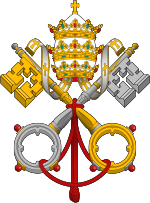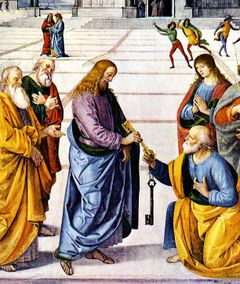Pope Sixtus I
| Saint Sixtus I | |
|---|---|
 |
|
| Papacy began | 117 or 119 |
| Papacy ended | 126 or 128 |
| Predecessor | Alexander I |
| Successor | Telesphorus |
| Personal details | |
| Birth name | Sixtus or Xystus |
| Born | 42 Rome, Italy |
| Died | 126 or 128 Rome, Italy |
| Sainthood | |
| Feast day | April 6 |
| Title as Saint | Martyr |
| Other Popes named Sixtus | |
| Papal styles of Pope Sixtus I |
|
|---|---|
 |
|
| Reference style | His Holiness |
| Spoken style | Your Holiness |
| Religious style | Holy Father |
| Posthumous style | Saint |
Pope Saint Sixtus I was bishop of Rome from about 117 or 119 to 126 or 128 C.E., succeeding Pope Alexander I and succeeded by Pope Telesphorus. In the oldest documents, Xystus is the spelling used for the first three popes of that name.
The Holy See's Annuario Pontificio (2003) identifies him as a Roman who reigned from 117 or 119 to 126 or 128. According to the Liberian Catalogue of popes, he ruled the Church during the reign of Hadrian "a consulatu Negro et Aproniani usque Vero III et Ambibulo", that is, from 117 to 126.
Eusebius states in his Chronicon that Sixtus I was pope from 114 to 124, while his Historia Ecclesiastica, using a different catalogue of popes, claims his rule from 114 to 128. All authorities agree that he reigned about ten years.
Sixtus I is credited as having instituted several Roman Catholic liturgical and administrative traditions, but historians believe that these were attributed to him by later writers who were interested in bolstering the papacy's claims to ancient supremacy. Like most of his predecessors, Sixtus I was believed to be buried near Saint Peter's grave on Vatican Hill, although there are differing traditions concerning where his body lies today.
He was a Roman by birth, and his father's name was Pastor. According to the Liber Pontificalis (ed. Duchesne, I.128), he passed the following three ordinances:
- that none but sacred ministers are allowed to touch the sacred vessels;
- that bishops who have been summoned to the Holy See shall, upon their return, not be received by their diocese except on presenting Apostolic letters;
- that after the Preface in the Mass the priest shall recite the Sanctus with the people.
Regarding the dates of Sixtus I, according to the Liberian Catalogue of popes, he ruled the Church during the reign of Hadrian "a consulatu Negro et Aproniani usque Vero III et Ambibulo," that is, from 117 to 126. The fourth century church historian Eusebius, however, states in his Chronicon that Sixtus I was pope from 114 to 124, while his Historia Ecclesiastica, using a different list, claims that Sixtus' rule was from 114 to 128.
The Felician Catalogue of popes and the various martyrologies style him martyr. St. Irenaeus of Lyons, writing in the second century, says nothing of his martyrdom; his successor Telesphorus is the first pope after St. Peter whom Irenaeus designates a martyr.
He was buried on Vatican Hill, beside the tomb of St. Peter. His relics are said to have been transferred to Alatri in 1132, though O. Jozzi ("Il corpo di S. Sisto I., papa e martire rivendicato alla basilica Vaticana", Rome, 1900) contends that they are still in the Vatican Basilica.
Alban Butler (Lives of the Saints, 6 April) states that Clement X gave some of his relics to Cardinal de Retz, who placed them in the Abbey of St. Michael in Lorraine. The Xystus who is commemorated in the Catholic Canon of the Mass is Xystus II, not Xystus I.
His feast is celebrated on April 6.
References
- Benedict XVI. The Roman Martyrology. Gardners Books, 2007. ISBN 9780548133743.
- Chapman, John. Studies on the Early Papacy. Port Washington, NY: Kennikat Press, 1971. ISBN 9780804611398.
- Fortescue, Adrian, and Scott M. P. Reid. The Early Papacy: To the Synod of Chalcedon in 451. Southampton: Saint Austin Press, 1997. ISBN 9781901157604.
- Jowett, George F. The Drama of the Lost Disciples. London: Covenant Pub. Co, 1968. OCLC 7181392
- Loomis, Louise Ropes. The Book of Popes (Liber Pontificalis). Merchantville, NJ: Evolution Publishing. ISBN 1889758868.
![]() This article incorporates text from a publication now in the public domain: Herbermann, Charles, ed (1913). Catholic Encyclopedia. Robert Appleton Company.
This article incorporates text from a publication now in the public domain: Herbermann, Charles, ed (1913). Catholic Encyclopedia. Robert Appleton Company.
External links
- Image of Pope Saint Sixtus as seen on a fresco at Chalivoy-Milon in the Berry.
| Catholic Church titles | ||
|---|---|---|
| Preceded by Alexander I |
Bishop of Rome Pope 115–125 |
Succeeded by Telesphorus |
|
|||||||||||||||||||||||||||||||||||||||||||||
|
|||||||||||||||||||||||||||||||||||||||||

